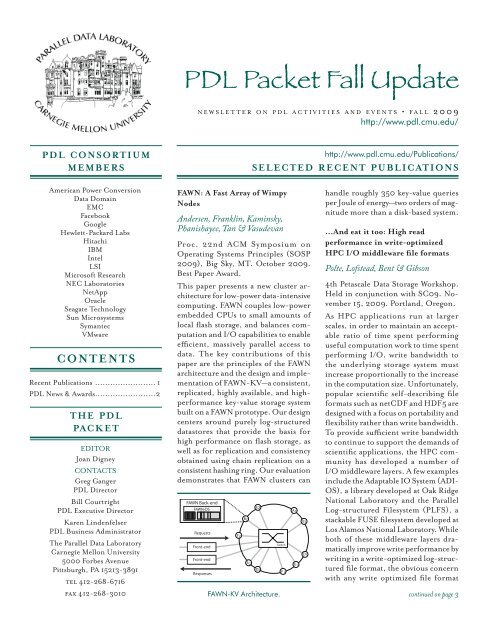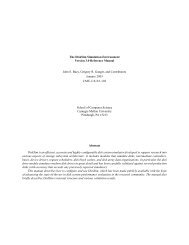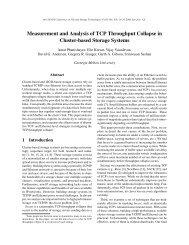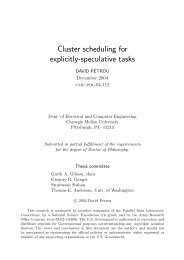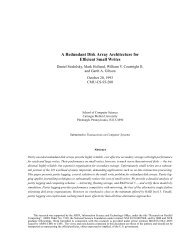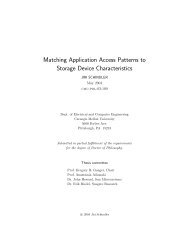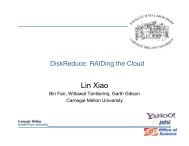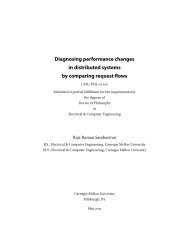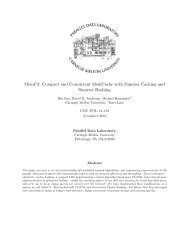2009 PDL Packet Fall Update - Parallel Data Lab - Carnegie Mellon ...
2009 PDL Packet Fall Update - Parallel Data Lab - Carnegie Mellon ...
2009 PDL Packet Fall Update - Parallel Data Lab - Carnegie Mellon ...
You also want an ePaper? Increase the reach of your titles
YUMPU automatically turns print PDFs into web optimized ePapers that Google loves.
n e w s l e t t e r o n p d l a c t i v i t i e s a n d e v e n t s • f a l l 2 0 0 9<br />
http://www.pdl.cmu.edu/<br />
pdl consortium<br />
Members<br />
http://www.pdl.cmu.edu/Publications/<br />
Selected Recent publications<br />
American Power Conversion<br />
<strong>Data</strong> Domain<br />
EMC<br />
Facebook<br />
Google<br />
Hewlett-Packard <strong>Lab</strong>s<br />
Hitachi<br />
IBM<br />
Intel<br />
LSI<br />
Microsoft Research<br />
NEC <strong>Lab</strong>oratories<br />
NetApp<br />
Oracle<br />
Seagate Technology<br />
Sun Microsystems<br />
Symantec<br />
VMware<br />
contents<br />
Recent Publications......................... 1<br />
<strong>PDL</strong> News & Awards........................2<br />
The <strong>PDL</strong><br />
packet<br />
EDITOR<br />
Joan Digney<br />
CONTACTS<br />
Greg Ganger<br />
<strong>PDL</strong> Director<br />
Bill Courtright<br />
<strong>PDL</strong> Executive Director<br />
Karen Lindenfelser<br />
<strong>PDL</strong> Business Administrator<br />
The <strong>Parallel</strong> <strong>Data</strong> <strong>Lab</strong>oratory<br />
<strong>Carnegie</strong> <strong>Mellon</strong> University<br />
5000 Forbes Avenue<br />
Pittsburgh, PA 15213-3891<br />
tel 412-268-6716<br />
fax 412-268-3010<br />
FAWN: A Fast Array of Wimpy<br />
Nodes<br />
Andersen, Franklin, Kaminsky,<br />
Phanishayee, Tan & Vasudevan<br />
Proc. 22nd ACM Symposium on<br />
Operating Systems Principles (SOSP<br />
<strong>2009</strong>), Big Sky, MT. October <strong>2009</strong>.<br />
Best Paper Award.<br />
This paper presents a new cluster architecture<br />
for low-power data-intensive<br />
computing. FAWN couples low-power<br />
embedded CPUs to small amounts of<br />
local flash storage, and balances computation<br />
and I/O capabilities to enable<br />
efficient, massively parallel access to<br />
data. The key contributions of this<br />
paper are the principles of the FAWN<br />
architecture and the design and implementation<br />
of FAWN-KV—a consistent,<br />
replicated, highly available, and highperformance<br />
key-value storage system<br />
built on a FAWN prototype. Our design<br />
centers around purely log-structured<br />
datastores that provide the basis for<br />
high performance on flash storage, as<br />
well as for replication and consistency<br />
obtained using chain replication on a<br />
consistent hashing ring. Our evaluation<br />
demonstrates that FAWN clusters can<br />
FAWN Back-end<br />
FAWN-DS<br />
Requests<br />
Front-end<br />
Front-end<br />
Responses<br />
F2<br />
B2<br />
A2<br />
E2<br />
D2<br />
Switch<br />
FAWN-KV Architecture.<br />
F1<br />
A1<br />
E1<br />
B1<br />
D1<br />
handle roughly 350 key-value queries<br />
per Joule of energy—two orders of magnitude<br />
more than a disk-based system.<br />
...And eat it too: High read<br />
performance in write-optimized<br />
HPC I/O middleware file formats<br />
Polte, Lofstead, Bent & Gibson<br />
4th Petascale <strong>Data</strong> Storage Workshop.<br />
Held in conjunction with SC09. November<br />
15, <strong>2009</strong>. Portland, Oregon.<br />
As HPC applications run at larger<br />
scales, in order to maintain an acceptable<br />
ratio of time spent performing<br />
useful computation work to time spent<br />
performing I/O, write bandwidth to<br />
the underlying storage system must<br />
increase proportionally to the increase<br />
in the computation size. Unfortunately,<br />
popular scientific self-describing file<br />
formats such as netCDF and HDF5 are<br />
designed with a focus on portability and<br />
flexibility rather than write bandwidth.<br />
To provide sufficient write bandwidth<br />
to continue to support the demands of<br />
scientific applications, the HPC community<br />
has developed a number of<br />
I/O middleware layers. A few examples<br />
include the Adaptable IO System (ADI-<br />
OS), a library developed at Oak Ridge<br />
National <strong>Lab</strong>oratory and the <strong>Parallel</strong><br />
Log-structured Filesystem (PLFS), a<br />
stackable FUSE filesystem developed at<br />
Los Alamos National <strong>Lab</strong>oratory. While<br />
both of these middleware layers dramatically<br />
improve write performance by<br />
writing in a write-optimized log-structured<br />
file format, the obvious concern<br />
with any write optimized file format<br />
continued on page 3
pdl news & awards<br />
October <strong>2009</strong><br />
Adrian Perrig<br />
Wins Award<br />
for Innovative<br />
Cybersecurity<br />
Research<br />
Adrian Perrig<br />
w a s a w a rd e d<br />
a Security 7<br />
Award from Information Security<br />
magazine for innovative cybersecurity<br />
research in academia. Perrig, technical<br />
director of <strong>Carnegie</strong> <strong>Mellon</strong> Cy<strong>Lab</strong>, a<br />
professor in the departments of Electrical<br />
and Computer Engineering and<br />
Engineering and Public Policy, and the<br />
School of Computer Science, will be<br />
recognized in the magazine’s October<br />
issue. The magazine’s editor, Michael<br />
S. Mimoso, said the awards recognize<br />
the achievements of security practitioners<br />
and researchers in a variety of<br />
industries, including education.<br />
--CMU 8.5x11 News, Oct 15, <strong>2009</strong><br />
October <strong>2009</strong><br />
Honorable Mention for Leskovec’s<br />
Dissertation<br />
Congratulations to Jure Leskovec who<br />
has been awarded<br />
an honorable<br />
mention in the<br />
SCS Dissertation<br />
of the year<br />
c o m p e t i t i o n<br />
for his thesis<br />
on “Dynamics<br />
of Large Networks.”<br />
We wish<br />
him luck as his dissertation is also<br />
being submitted as one of <strong>Carnegie</strong><br />
<strong>Mellon</strong>’s entries for the ACM doctoral<br />
dissertation award.<br />
October <strong>2009</strong><br />
Best Paper Award from SOSP’09 in<br />
Big Sky, Montana!<br />
Huge congratulations to Amar Phanishayee,<br />
Jason Franklin, Lawrence Tan,<br />
Vijay Vasudevan and Dave Andersen<br />
on their best paper award at the 22nd<br />
ACM Symposium on Operating Systems<br />
Principles (SOSP ‘09). Their<br />
paper “FAWN: A Fast Array of Wimpy<br />
Nodes” presents a new cluster architecture<br />
for low-power data-intensive<br />
computing.<br />
August <strong>2009</strong><br />
Nikos Hardavellas Appointed to<br />
June & Donald Brewer Chair of<br />
EE/CS at Northwestern<br />
Congratulations to Nikos, June and<br />
Donald Brewer<br />
Assistant Professor<br />
of Electrical<br />
Engineering<br />
and Computer<br />
Science at<br />
Northwestern<br />
University. He<br />
has been appointed<br />
to the<br />
endowed chair for a two-year period<br />
from September 1, <strong>2009</strong> to August<br />
31, 2011. Along with the title and<br />
honor, Prof. Hardavellas will receive a<br />
discretionary fund for each of the two<br />
years. This chair is awarded to Northwestern<br />
University’s very best young<br />
faculty in the McCormick School of<br />
Engineering.<br />
August <strong>2009</strong><br />
Cranor Receives NSF Funding<br />
for Interdisciplinary Doctoral<br />
Program in Privacy & Security<br />
Associate Professor Lorrie Cranor and<br />
her colleagues<br />
received a fiveyear,<br />
$3 million<br />
grant from the<br />
National Science<br />
Foundat<br />
i o n ( N S F )<br />
to establish a<br />
Ph.D. program<br />
in usable privacy<br />
and security. “<strong>Carnegie</strong> <strong>Mellon</strong>’s<br />
Cy<strong>Lab</strong> Usable Privacy and Security<br />
(CUPS) Doctoral Training Program<br />
will offer Ph.D. students a new crossdisciplinary<br />
training experience that<br />
helps them produce solutions to<br />
ongoing tensions between security,<br />
privacy and usability,” said Cranor,<br />
associate professor in the Institute for<br />
Software Research, the Department<br />
of Engineering and Public Policy and<br />
<strong>Carnegie</strong> <strong>Mellon</strong> Cy<strong>Lab</strong>. She noted<br />
that students will be actively involved<br />
in <strong>Carnegie</strong> <strong>Mellon</strong>’s broad usable<br />
privacy and security research, which<br />
spans three major approaches: finding<br />
ways to build systems that “just<br />
work” without involving humans in<br />
security-critical functions; finding<br />
ways of making secure systems intuitive<br />
and easy to use; and finding ways to effectively<br />
teach humans how to perform<br />
security-critical tasks.<br />
--CMU 8.5x11 News, August 27, <strong>2009</strong><br />
August <strong>2009</strong><br />
Priya follows up the YinzCam with<br />
iBurgh<br />
Pittsburgh is the first U.S. city with<br />
its own iPhone<br />
app. iBurgh,<br />
developed by<br />
Priya Narasimhan<br />
and her research<br />
group,<br />
allows users to<br />
take a picture of<br />
civic problems<br />
such as potholes,<br />
graffiti or other hazards and directly<br />
upload them, accompanied by a<br />
GPS location, to city council and other<br />
municipal administration authorities<br />
for review. Previous to the iBurgh<br />
app, Priya and her group launched<br />
the YinzCam, another mobile phone<br />
app which allows hockey fans to view<br />
replays and alternate action angles at<br />
Pittsburgh Penguins hockey games on<br />
their phones or other handheld WiFi<br />
devices.<br />
To top off all Priya’s good news,<br />
YinzCam made Network World’s top<br />
10 list of sports innovations to love!<br />
(http://www.networkworld.com/<br />
slideshows/<strong>2009</strong>/081809-sportstechnologies.html<br />
-- slide 10).<br />
continued on page 8<br />
2 t h e p d l p a c k e t
ecent publications<br />
continued from page 1<br />
would be a corresponding penalty on<br />
reads. Simulation results require efficient<br />
read-back for visualization and<br />
analytics and while most checkpoint<br />
files are never used, the efficiency of<br />
restart is still important in the face of<br />
inevitable failures. The utility of write<br />
speed improving middleware would<br />
be greatly diminished without acceptable<br />
read performance. In this paper<br />
we examine the read performance on<br />
large parallel machines and compare<br />
these to reading data either natively<br />
or to other popular file formats. We<br />
compare the reading performance in<br />
two different scenarios: 1) Reading<br />
back restarts from the same number<br />
of processors which wrote the data and<br />
2) Reading back restart data from a<br />
different number of processors which<br />
wrote the data and demonstrate that<br />
the log-structured file formats actually<br />
improve read-back performance<br />
due to the particular writing and read<br />
back patterns of HPC checkpoints and<br />
applications.<br />
DiskReduce: RAID for <strong>Data</strong>-<br />
Intensive Scalable Computing<br />
Fan, Tantisiriroj, Xiao & Gibson<br />
4th Petascale <strong>Data</strong> Storage Workshop.<br />
Held in conjunction with SC09. November<br />
15, <strong>2009</strong>. Portland, Oregon.<br />
<strong>Data</strong>-intensive file systems, developed<br />
for Internet services and popular in<br />
cloud computing, provide high reliability<br />
and availability by replicating<br />
data, typically three copies of everything.<br />
While high performance computing,<br />
which has comparable scale,<br />
and smaller scale enterprise storage<br />
systems get similar tolerance for multiple<br />
failures from lower overhead<br />
erasure encoding, or RAID, organizations.<br />
DiskReduce is a modification<br />
of the Hadoop file system (HDFS)<br />
enabling asynchronous compression<br />
of initially triplicated data down to<br />
RAID-class redundancy overheads,<br />
and asynchronous repair of lost data.<br />
In addition to increasing a cluster’s<br />
storage capacity as seen by its users by<br />
D 2<br />
D 1<br />
D 1 D 2<br />
D 1 D 2<br />
Codewords providing protection against<br />
double node failures.<br />
up to a factor of three, DiskReduce can<br />
delay encoding long enough to deliver<br />
the performance benefits of multiple<br />
data copies. DiskReduce also gathers<br />
data into encoding groups that is likely<br />
to be deleted closely enough in time to<br />
avoid re-encoding data as it is deleted<br />
Co-scheduling of Disk Head Time<br />
in Cluster-based Storage<br />
Wachs & Ganger<br />
(a) Triplication<br />
2xN <strong>Data</strong> Entries<br />
Coding Entry<br />
(b) Raid 5 and mirror<br />
(c) RAID 6<br />
...<br />
D 1 D 2<br />
... D N<br />
D 1 D 2<br />
... D N<br />
P<br />
N <strong>Data</strong> entries<br />
D 1 D 2<br />
... D N<br />
2 Coding Entries<br />
P 1<br />
P 2<br />
D N<br />
D N<br />
D N<br />
28th International Symposium On<br />
Reliable Distributed Systems September<br />
27-30, <strong>2009</strong>. Niagara <strong>Fall</strong>s, New<br />
York, U.S.A.<br />
Disk timeslicing is a promising technique<br />
for storage performance insulation.<br />
To work with cluster-based<br />
storage, however, timeslices associated<br />
with striped data must be co-scheduled<br />
on the corresponding servers. This<br />
paper describes algorithms for determining<br />
global timeslice schedules<br />
and mechanisms for coordinating<br />
the independent server activities. Experiments<br />
with a prototype show that,<br />
combined, they can provide performance<br />
insulation for workloads sharing<br />
a storage cluster—each workload<br />
realizes a configured minimum efficiency<br />
within its timeslices regardless<br />
of the activities of the other workloads.<br />
Improving OLTP Scalability using<br />
Speculative Lock Inheritance<br />
Johnson, Pandis & Ailamaki<br />
35th International Conference on<br />
Very Large <strong>Data</strong> Bases (VLDB<strong>2009</strong>),<br />
Lyon, France, August <strong>2009</strong>.<br />
Transaction processing workloads provide<br />
ample request level concurrency<br />
which highly parallel architectures can<br />
exploit. However, the resulting heavy<br />
utilization of core database services<br />
also causes resource contention within<br />
the database engine itself and limits<br />
scalability. Meanwhile, many database<br />
workloads consist of short transactions<br />
which access only a few database<br />
records each, often with stringent<br />
response time requirements. Performance<br />
of these short transactions is<br />
determined largely by the amount of<br />
overhead the database engine imposes<br />
for services such as logging, locking,<br />
and transaction management.<br />
This paper highlights the negative<br />
scalability impact of database locking,<br />
an effect which is especially severe for<br />
Work per Xct (cpu-usec)<br />
300<br />
200<br />
100<br />
0<br />
Other Work<br />
Other Contention<br />
LM Overhead<br />
LM Contention<br />
continued on page 4<br />
418<br />
2% 11% 48% 67% 86% 98%<br />
System Load<br />
Lock manager overhead as system load<br />
increases.<br />
f a l l 2008 3
Safe and Effective Fine-grained<br />
TCP Retransmissions for<br />
<strong>Data</strong>center Communication<br />
Vasudevan, Phanishayee, Shah,<br />
Krevat, Andersen, Ganger, Gibson &<br />
Mueller<br />
SIGCOMM’09, August 17–21, <strong>2009</strong>,<br />
Barcelona, Spain.<br />
This paper presents a practical solution<br />
to a problem facing high-fan-in, highbandwidth<br />
synchronized TCP workloads<br />
in datacenter Ethernets|the TCP<br />
incast problem. In these networks, rerecent<br />
publications<br />
continued from page 3<br />
short transactions running on highly<br />
concurrent multicore hardware. We<br />
propose and evaluate Speculative Lock<br />
Inheritance, a technique where hot database<br />
locks pass directly from transaction<br />
to transaction, bypassing the lock<br />
manager bottleneck. We implement<br />
SLI in the Shore-MT storage manager<br />
and show that lock inheritance<br />
fundamentally improves scalability by<br />
decoupling the number of simultaneous<br />
requests for popular locks from<br />
the number of threads in the system,<br />
eliminating contention within the lock<br />
manager even as core counts continue<br />
to increase. We achieve this effect with<br />
only minor changes to the lock manager<br />
and without changes to consistency<br />
or other application-visible effects.<br />
# of Occurrences<br />
RTT Distribution in SAN<br />
10000<br />
9000<br />
8000<br />
7000<br />
6000<br />
5000<br />
4000<br />
3000<br />
2000<br />
1000<br />
0<br />
0 100 200 300 400 500 600 700 800 900 1000<br />
RTT in Microseconds<br />
During an incast experiment on a cluster<br />
RTTs increase by 4 times the baseline RTT<br />
(100µs)on average with spikes as high as<br />
800µs. This produces RTO values in the<br />
range of 1-3ms, resulting in an RTO min<br />
of<br />
1ms being as effective as 200µs in today’s<br />
networks.<br />
ceivers can experience a drastic reduction<br />
in application throughput when<br />
simultaneously requesting data from<br />
many servers using TCP. Inbound data<br />
overfills small switch buffers, leading<br />
to TCP timeouts lasting hundreds of<br />
milliseconds. For many datacenter<br />
workloads that have a barrier synchronization<br />
requirement (e.g., filesystem<br />
reads and parallel data-intensive queries),<br />
throughput is reduced by up to<br />
90%. For latency-sensitive applications,<br />
TCP timeouts in the datacenter<br />
impose delays of hundreds of milliseconds<br />
in networks with round-triptimes<br />
in microseconds. Our practical<br />
solution uses high-resolution timers<br />
to enable microsecond-granularity<br />
TCP timeouts. We demonstrate that<br />
this technique is effective in avoiding<br />
TCP incast collapse in simulation<br />
and in real-world experiments. We<br />
show that eliminating the minimum<br />
retransmission timeout bound is safe<br />
for all environments, including the<br />
wide-area.<br />
On the Inapproximability of M/G/K:<br />
Why Two Moments of Job Size Distribution<br />
are Not Enough<br />
Gupta, Harchol-Balter, Dai & Zwart<br />
Queueing Systems: Theory and Applications,<br />
August <strong>2009</strong>.<br />
The M/G/K queueing system is one<br />
of the oldest models for multiserver<br />
systems and has been the topic of<br />
performance papers for almost half<br />
a century. However, even now, only<br />
coarse approximations exist for its<br />
mean waiting time. All the closedform<br />
(nonnumerical) approximations<br />
in the literature are based on (at most)<br />
the first two moments of the job size<br />
distribution. In this paper we prove<br />
that no approximation based on only<br />
the first two moments can be accurate<br />
for all job size distributions, and we<br />
provide a lower bound on the inapproximability<br />
ratio, which we refer to<br />
as “the gap.” This is the first such result<br />
in the literature to address “the gap.”<br />
The Perspective Home Storage team at the<br />
<strong>PDL</strong> Spring Industry Visit Day. From L to<br />
R, Zoheb Shivani, Nitin Gupta, Brandon<br />
Salmon and Michelle Mazurek.<br />
is novel as well and combines mean<br />
value analysis, sample path techniques,<br />
scheduling, regenerative arguments,<br />
and asymptotic estimates. Finally, our<br />
work provides insight into the effect<br />
of higher moments of the job size<br />
distribution on the mean waiting time.<br />
RTG: A Recursive Realistic Graph<br />
Generator using Random Typing<br />
Akoglu & Faloutsos<br />
ECML PKDD, Bled, Slovenia, Sept.<br />
<strong>2009</strong>. Best Knowledge Discovery<br />
Paper award.<br />
We propose a new, recursive model to<br />
generate realistic graphs, evolving over<br />
time. Our model has the following<br />
properties: it is (a) flexible, capable of<br />
generating the cross product of weighted/unweighted,<br />
directed/ undirected,<br />
uni/bipartite graphs; (b) realistic, giving<br />
graphs that obey eleven static and<br />
dynamic laws that real graphs follow<br />
(we formally prove that for several of<br />
the (power) laws and we estimate their<br />
exponents as a function of the model<br />
parameters); (c) parsimonious, requiring<br />
only four parameters. (d) fast,<br />
being linear on the number of edges;<br />
(e) simple, intuitively leading to the<br />
generation of macroscopic patterns.<br />
We empirically show that our model<br />
mimics two real-world graphs very<br />
well: Blognet (unipartite, undirected,<br />
unweighted) with 27K nodes and 125K<br />
The proof technique behind this result continued on page 5<br />
4 t h e p d l p a c k e t
ecent publications<br />
continued from page 5<br />
p<br />
p<br />
a b S<br />
p q p q<br />
p p<br />
a b S a b S<br />
p q<br />
p<br />
. . . . . . . . . . . .<br />
ab a bba ab b ab a b ab a<br />
A B space<br />
Illustration of the RTG-IE. Upper left: how words are (recursively) generated on a keyboard<br />
with two equiprobable keys, ‘a’ and ‘b’, and a space bar; lower left:a keyboard is used<br />
to randomly type words, separated by the space character; upper right: how words are<br />
organized in pairs to create source and destination nodes in the graph over time; lower<br />
right: the output graph; each node label corresponds to a unique word, while labels on<br />
edges denote weights.<br />
edges; and Committee-to-Candidate<br />
campaign donations (bipartite, directed,<br />
weighted) with 23K nodes<br />
and 880K edges. We also show how to<br />
handle time so that edge/weight additions<br />
are bursty and self-similar.<br />
No Downtime for <strong>Data</strong> Conversions:<br />
Rethinking Hot Upgrades<br />
Dumitraş & Narasimhan<br />
<strong>Carnegie</strong> <strong>Mellon</strong> University <strong>Parallel</strong><br />
<strong>Data</strong> <strong>Lab</strong> Technical Report CMU-<br />
<strong>PDL</strong>-09-106. July <strong>2009</strong>.<br />
Unavailability in enterprise systems is<br />
usually the result of planned events,<br />
such as upgrades, rather than failures.<br />
Major system upgrades entail complex<br />
data conversions that are difficult to<br />
perform on the fly, in the face of live<br />
workloads. Minimizing the downtime<br />
imposed by such conversions is a timeintensive<br />
and error-prone manual<br />
process. We present Imago, a system<br />
that aims to simplify the upgrade process,<br />
and we show that it can eliminate<br />
all the causes of planned downtime<br />
recorded during the upgrade history<br />
of one of the ten most popular websites.<br />
Building on the lessons learned<br />
from past research on live upgrades in<br />
middleware systems, Imago trades off a<br />
q<br />
Time<br />
T1<br />
T2<br />
T3<br />
T4<br />
T5<br />
Source<br />
ab<br />
bba<br />
b<br />
a<br />
ab<br />
bba<br />
Destination<br />
a<br />
ab<br />
ab<br />
b<br />
a<br />
b<br />
1 1 1<br />
2<br />
ab<br />
a<br />
Weight<br />
need for additional storage resources<br />
for the ability to perform end-to-end,<br />
enterprise upgrades online, with minimal<br />
application-specific knowledge.<br />
Optimal Power Allocation in Server<br />
Farms<br />
Gandhi, Harchol-Balter, Das &<br />
Lefurgy<br />
Proceedings of ACM SIGMETRICS<br />
<strong>2009</strong> Conference on Measurement<br />
and Modeling of Computer Systems.<br />
Seattle, WA, June <strong>2009</strong>.<br />
Server farms today consume more than<br />
1.5% of the total electricity in the U.S.<br />
at a cost of nearly $4.5 billion. Given<br />
the rising cost of energy, many industries<br />
are now seeking solutions for<br />
how to best make use of their available<br />
power. An important question which<br />
arises in this context is how to distribute<br />
available power among servers in<br />
a server farm so as to get maximum<br />
performance.<br />
By giving more power to a server,<br />
one can get higher server frequency<br />
(speed). Hence it is commonly believed<br />
that, for a given power budget,<br />
performance can be maximized by operating<br />
servers at their highest power<br />
1<br />
1<br />
1<br />
1<br />
1<br />
levels. However, it is also conceivable<br />
that one might prefer to run servers at<br />
their lowest power levels, which allows<br />
more servers to be turned on for a given<br />
power budget. To fully understand<br />
the effect of power allocation on performance<br />
in a server farm with a fixed<br />
power budget, we introduce a queueing<br />
theoretic model, which allows us to<br />
predict the optimal power allocation<br />
in a variety of scenarios. Results are<br />
verified via extensive experiments on<br />
an IBM BladeCenter. We find that the<br />
optimal power allocation varies for<br />
different scenarios. In particular, it<br />
is not always optimal to run servers at<br />
their maximum power levels. There<br />
are scenarios where it might be optimal<br />
to run servers at their lowest power<br />
levels or at some intermediate power<br />
levels. Our analysis shows that the optimal<br />
power allocation is non-obvious<br />
and depends on many factors such as<br />
the power-to-frequency relationship<br />
in the processors, the arrival rate of<br />
jobs, the maximum server frequency,<br />
the lowest attainable server frequency<br />
and the server farm configuration.<br />
Furthermore, our theoretical model<br />
allows us to explore more general settings<br />
than we can implement, including<br />
arbitrarily large server farms and<br />
different power-to-frequency curves.<br />
Importantly, we show that the optimal<br />
power allocation can significantly improve<br />
server farm performance, by a<br />
factor of typically 1.4 and as much as a<br />
factor of 5 in some cases.<br />
Perspective: Semantic <strong>Data</strong><br />
Management for the Home<br />
Salmon, Schlosser, L. Cranor &<br />
Ganger<br />
;LOGIN: Vol. 34, No. 5<br />
Distributed storage is coming home.<br />
An increasing number of home and<br />
personal electronic devices create,<br />
use, and display digitized forms of<br />
music, images, and videos, as well as<br />
more conventional files (e.g. financial<br />
records and contact lists). In-home<br />
continued on page 6<br />
f a l l 2008 5
ecent publications<br />
continued from page 5<br />
networks enable these devices to<br />
communicate, and a variety of devicespecific<br />
and datatype-specific tools are<br />
emerging. The transition to digital<br />
homes gives exciting new capabilities to<br />
users, but it also makes them responsible<br />
for administration tasks which in<br />
other settings are usually handled by<br />
dedicated professionals.<br />
Power Capping Via Forced Idleness<br />
Gandhi, Harchol-Balter, Das, Kephart<br />
& Lefurgy<br />
Workshop on Energy-Efficient Design<br />
(WEED 09) Austin, Texas, June <strong>2009</strong>.<br />
We introduce a novel power capping<br />
technique, IdleCap, that achieves<br />
higher effective server frequency for a<br />
given power constraint than existing<br />
techniques. IdleCap works by repeatedly<br />
alternating between the highest<br />
performance state and a low-power<br />
idle state, maintaining a fixed average<br />
power budget, while significantly<br />
increasing the average processor frequency.<br />
In experiments conducted<br />
on an IBM BladeCenter HS21 server<br />
across three representative workloads,<br />
IdleCap reduces the mean response<br />
time by up to a factor of 3 when compared<br />
to power capping using clockthrottling.<br />
Furthermore, we argue how<br />
IdleCap applies to next-generation<br />
servers using DVFS and advanced idle<br />
states.<br />
In Search of an API for Scalable<br />
File Systems: Under the table or<br />
above it?<br />
Patil, Gibson, Ganger, López, Polte,<br />
Tantisiriroj & Xiao<br />
USENIX HotCloud Workshop <strong>2009</strong>.<br />
June <strong>2009</strong>, San Diego CA.<br />
“Big <strong>Data</strong>” is everywhere – both the IT<br />
industry and the scientific computing<br />
community are routinely handling<br />
terabytes to petabytes of data [24]. This<br />
preponderance of data has fueled the<br />
development of data-intensive scalable<br />
computing (DISC) systems that<br />
manage, process and store massive<br />
data-sets in a distributed manner. For<br />
example, Google and Yahoo have built<br />
their respective Internet services stack<br />
to distribute processing (MapReduce<br />
and Hadoop), to program computation<br />
(Sawzall and Pig) and to store the<br />
structured output data (Bigtable and<br />
HBase). Both these stacks are layered<br />
on their respective distributed file<br />
systems, GoogleFS [12] and Hadoop<br />
distributed FS [15], that are designed<br />
“from scratch” to deliver high performance<br />
primarily for their anticipated<br />
DISC workloads.<br />
However, cluster file systems have been<br />
used by the high performance computing<br />
(HPC) community at even larger<br />
scales for more than a decade. These<br />
cluster file systems, including IBM<br />
GPFS [28], Panasas PanFS [34], PVFS<br />
[26] and Lustre [21], are required to<br />
meet the scalability demands of highly<br />
parallel I/O access patterns generated<br />
by scientific applications that execute<br />
simultaneously on tens to hundreds<br />
of thousands of nodes. Thus, given<br />
the importance of scalable storage to<br />
both the DISC and the HPC world,<br />
we take a step back and ask ourselves if<br />
we are at a point where we can distill<br />
the key commonalities of these scalable<br />
file systems.<br />
This is not a paper about engineering<br />
yet another “right” file system or<br />
database, but rather about how do we<br />
evolve the most dominant data storage<br />
API – the file system interface – to<br />
provide the right abstraction for both<br />
DISC and HPC applications. What<br />
structures should be added to the file<br />
system to enable highly scalable and<br />
highly concurrent storage? Our goal is<br />
not to define the API calls per se, but<br />
to identify the file system abstractions<br />
that should be exposed to programmers<br />
to make their applications more<br />
powerful and portable. This paper<br />
highlights two such abstractions. First,<br />
we show how commodity large-scale<br />
file systems can support distributed<br />
data processing enabled by the Hadoop/MapReduce<br />
style of parallel<br />
programming frameworks. And second,<br />
we argue for an abstraction that<br />
supports indexing and searching based<br />
on extensible attributes, by interpreting<br />
BigTable [6] as a file system with a<br />
filtered directory scan interface.<br />
Self-Adaptive Admission Control<br />
Policies for Resource-Sharing<br />
Systems<br />
Gupta & Harchol-Balter<br />
Proceedings of ACM SIGMETRICS<br />
<strong>2009</strong> Conference on Measurement<br />
and Modeling of Computer Systems.<br />
Seattle, WA, June <strong>2009</strong>.<br />
We consider the problem of admission<br />
control in resource sharing systems,<br />
such as web servers and transaction<br />
processing systems, when the job<br />
size distribution has high variability,<br />
with the aim of minimizing the mean<br />
response time. It is well known that<br />
in such resource sharing systems,<br />
as the number of tasks concurrently<br />
sharing the resource is increased, the<br />
server throughput initially increases,<br />
due to more efficient utilization of<br />
resources, but starts falling beyond a<br />
certain point, due to resource contention<br />
and thrashing. Most admission<br />
control mechanisms solve this<br />
problem by imposing a fixed upper<br />
bound on the number of concurrent<br />
transactions allowed into the system,<br />
called the Multi-Programming-Limit<br />
(MPL), and making the arrivals which<br />
find the server full queue up. Almost<br />
always, the MPL is chosen to be the<br />
point that maximizes server efficiency.<br />
In this paper we abstract such resource<br />
sharing systems as a Processor Shar-<br />
FCFS<br />
MPL = 4<br />
continued on page 7<br />
PS<br />
A G/G/PS-MPL queue with MPL = 4. Only<br />
4 jobs can simultaneously share the server.<br />
The rest must wait outside in FCFS order.<br />
6 t h e p d l p a c k e t
ecent publications<br />
continued from page 6<br />
ing (PS) server with state-dependent<br />
service rate and a First-Come-First-<br />
Served (FCFS) queue, and we analyze<br />
the performance of this model from<br />
a queueing theoretic perspective.<br />
We start by showing that, counter to<br />
the common wisdom, the peak efficiency<br />
point is not always optimal<br />
for minimizing the mean response<br />
time. Instead, significant performance<br />
gains can be obtained by running the<br />
system at less than the peak efficiency.<br />
We provide a simple expression for the<br />
static MPL that achieves near-optimal<br />
mean response time for general distributions.<br />
Next we present two trafficoblivious<br />
dynamic admission control<br />
policies that adjust the MPL based on<br />
the instantaneous queue length while<br />
also taking into account the variability<br />
of the job size distribution. The structure<br />
of our admission control policies<br />
is a mixture of fluid control when the<br />
number of jobs in the system is high,<br />
with a stochastic component when the<br />
system is near-empty. We show via<br />
simulations that our dynamic policies<br />
are much more robust to unknown<br />
traffic intensities and burstiness in<br />
the arrival process than imposing a<br />
static MPL.<br />
Access Control for Home <strong>Data</strong><br />
Sharing: Attitudes, Needs and<br />
Practices<br />
Mazurek, Arsenault, Bresee, Gupta,<br />
Ion, Johns, Lee, Liang, Olsen, Salmon,<br />
Shay, Vaniea, Bauer, L. Cranor,<br />
Ganger & Reiter<br />
<strong>Carnegie</strong> <strong>Mellon</strong> University <strong>Parallel</strong><br />
<strong>Data</strong> <strong>Lab</strong> Technical Report CMU-<br />
<strong>PDL</strong>-09-110, October <strong>2009</strong>.<br />
As digital content becomes more<br />
prevalent in the home, non-technical<br />
users are increasingly interested in<br />
sharing that content with others and<br />
accessing it from multiple devices.<br />
Not much is known about how these<br />
users think about controlling access<br />
to this data. To better understand<br />
this, we conducted semi-structured,<br />
in-situ interviews with 33 users in<br />
15 households. We found that users<br />
create ad-hoc access-control mechanisms<br />
that do not always work; that<br />
their ideal polices are complex and<br />
multi-dimensional; that a priori policy<br />
specification is often insufficient; and<br />
that people’s mental models of access<br />
control and security are often<br />
misaligned with current systems. We<br />
detail these findings and present a set<br />
of associated guidelines for designing<br />
usable access-control systems for the<br />
home environment.<br />
System-Call Based Problem<br />
Diagnosis for PVFS<br />
Kasick, Bare, Marinelli, Tan, Gandhi<br />
& Narasimhan<br />
Proceedings of the 5th Workshop on<br />
Hot Topics in System Dependability<br />
(HotDep ‘09). Lisbon, Portugal. June<br />
<strong>2009</strong>.<br />
We present a syscall-based approach to<br />
automatically diagnose performance<br />
problems, server-to-client propagated<br />
errors, and server crash/hang problems<br />
in PVFS. Our approach compares<br />
the statistical and semantic attributes<br />
of syscalls across PVFS servers in order<br />
to diagnose the culprit server, under<br />
these problems, for different filesystem<br />
benchmarks—dd, PostMark and<br />
IOzone—in a PVFS cluster.<br />
Mochi: Visual Log-Analysis Based<br />
Tools for Debugging Hadoop<br />
Tan, Pan, Kavulya, Gandhi &<br />
Narasimhan<br />
Workshop on Hot Topics in Cloud<br />
Computing (HotCloud ‘09), San Diego,<br />
CA, on June 15, <strong>2009</strong>.<br />
Mochi, a new visual, log-analysis based<br />
debugging tool correlates Hadoop’s<br />
behavior in space, time and volume,<br />
and extracts a causal, unified controland<br />
data-flow model of Hadoop across<br />
the nodes of a cluster. Mochi’s analysis<br />
produces visualizations of Hadoop’s<br />
behavior using which users can reason<br />
about and debug performance issues.<br />
We provide examples of Mochi’s value<br />
in revealing a Hadoop job’s structure,<br />
in optimizing real-world workloads,<br />
and in identifying anomalous Hadoop<br />
behavior, on the Yahoo! M45 Hadoop<br />
cluster.<br />
Tashi: Location-aware Cluster<br />
Management<br />
Kozuch, Ryan, Gass, Schlosser,<br />
O’Hallaron, Cipar, Krevat, López,<br />
Stroucken & Ganger<br />
First Workshop on Automated Control<br />
for <strong>Data</strong>centers and Clouds<br />
(ACDC’09), Barcelona, Spain, June<br />
<strong>2009</strong>.<br />
Big <strong>Data</strong> applications, those that require<br />
large data corpora either for<br />
correctness or for fidelity, are becoming<br />
increasingly prevalent. Tashi is a<br />
cluster management system designed<br />
particularly for enabling cloud computing<br />
applications to operate on<br />
repositories of Big <strong>Data</strong>. These applications<br />
are extremely scalable but<br />
also have very high resource demands.<br />
A key technique for making such applications<br />
perform well is Location-<br />
Awareness. This paper demonstrates<br />
that location-aware applications can<br />
outperform those that are not location<br />
aware by factors of 3-11 and describes<br />
two general services developed for<br />
Tashi to provide location-awareness<br />
independently of the storage system.<br />
<strong>Data</strong> Throughput (Gb/s)<br />
6000<br />
5000<br />
4000<br />
3000<br />
2000<br />
1000<br />
0<br />
Random Placement<br />
Location-Aware Placement<br />
3.6X<br />
11X<br />
3.5X<br />
9.2X<br />
Disk-1G SSD-1G Disk-10G SSD-10G<br />
Performance comparison of location<br />
aware task placement with random task<br />
placement. The labels on the data bars<br />
show the performance improvement for<br />
the Location-Aware Placement relayive to<br />
the Random Placement.<br />
f a l l 2008 7
pdl news & Awards<br />
continued from page 2<br />
July <strong>2009</strong><br />
Carlos Guestrin Wins Presidential<br />
Early Career Award<br />
C a r l o s<br />
Guestrin, the<br />
Finmeccanica<br />
Assistant Professor<br />
of Computer<br />
Science<br />
and Machine<br />
Learning, has<br />
won a Presidential<br />
Early Career<br />
Award for Scientists and Engineers<br />
(PECASE), the highest honor bestowed<br />
by the U.S. government on<br />
scientists and engineers beginning<br />
their careers. He was nominated by the<br />
Department of Defense, which recognized<br />
him last year with the Office of<br />
Naval Research’s Young Investigator<br />
Award.<br />
The PECASE program recognizes 100<br />
scientists and engineers who show<br />
exceptional potential for leadership<br />
at the frontiers of knowledge. “These<br />
extraordinarily gifted young scientists<br />
and engineers represent the best in our<br />
country,” President Obama said. “With<br />
their talent, creativity and dedication,<br />
I am confident that they will lead their<br />
fields in new breakthroughs and discoveries<br />
and help us use science and<br />
technology to lift up our nation and<br />
our world.”<br />
For more on the PECASE award and<br />
Guestrin’s other honors, visit http://<br />
www.cmu.edu/news/archive/<strong>2009</strong>/<br />
July/july10_guestrinaward.shtml<br />
--CMU 8.5x11 News, July 16, <strong>2009</strong><br />
June <strong>2009</strong><br />
Greg Ganger Earns Prestigious HP<br />
Innovation Research Award<br />
Greg Ganger, a professor of electrical<br />
and computer engineering and director<br />
of the <strong>Parallel</strong> <strong>Data</strong> <strong>Lab</strong>, is among<br />
60 recipients worldwide who received<br />
<strong>2009</strong> HP Innovation Research<br />
Awards. The award encourages open<br />
collaboration with HP <strong>Lab</strong>s for mutually<br />
beneficial,<br />
high-impact<br />
research.<br />
Ganger, who<br />
also received<br />
an HP Innovation<br />
<strong>Lab</strong> Award<br />
in 2008, will<br />
lead a research<br />
initiative in<br />
collaboration with HP <strong>Lab</strong>s focused<br />
on data storage infrastructure issues,<br />
based on his winning proposal “Toward<br />
Scalable Self-Storage.”<br />
Ganger was chosen from a group of<br />
nearly 300 applicants from more<br />
than 140 universities in 29 countries<br />
on a range of topics within the eight<br />
high-impact research themes at HP<br />
labs - analytics, cloud computing,<br />
content transformation, digital commercial<br />
print, immersive interaction,<br />
information management, intelligent<br />
infrastructure and sustainability.<br />
Noah Smith, an assistant professor of<br />
language technologies and machine<br />
learning at CMU, also received this<br />
award.<br />
“This award recognizes the ongoing<br />
innovative and cutting-edge work that<br />
<strong>Carnegie</strong> <strong>Mellon</strong> professors bring to<br />
all collaborative research efforts,” said<br />
Mark S. Kamlet, <strong>Carnegie</strong> <strong>Mellon</strong><br />
provost and senior vice president. “We<br />
are proud of their accomplishments<br />
and the vital impact their research will<br />
have for a variety of industry sectors.”<br />
--CMU 8.5x11 News, June 17, <strong>2009</strong><br />
June <strong>2009</strong><br />
Jure Leskovek Wins Doctoral<br />
Dissertation Award<br />
Jure Leskovec won the prestigious<br />
<strong>2009</strong> SIGKDD Doctoral Dissertation<br />
Award from the Association of Computing<br />
Machinery’s Special Interest<br />
Group on Knowledge Discovery and<br />
<strong>Data</strong> Mining for his thesis “Dynamics<br />
of Large Networks.” He was advised<br />
by School of Computer Science Professor<br />
Christos Faloutsos, who also<br />
advised the 2008 runner-up Jimeng<br />
Sun. Leskovec will present a short<br />
summary of his work at the SIGKDD<br />
Conference in Paris on Sunday, June<br />
28. For more: http://www.sigkdd.org/<br />
awards_dissertation.php<br />
--CMU 8.5x11 News, June 4, <strong>2009</strong><br />
May <strong>2009</strong><br />
Polo Chau Selected as Future<br />
Thought Leader by Yahoo!<br />
Ya h o o ! h a s<br />
n a m e d f o u r<br />
Ph.D. students<br />
in the School of<br />
Computer Science<br />
among 20<br />
winners of its<br />
inaugural Key<br />
Scientific Challenges<br />
program,<br />
which recognizes<br />
outstanding graduate-student researchers<br />
with the potential to become<br />
thought leaders in their fields. Polo<br />
Chau (advised by Christos Faloutsos)<br />
of the Machine Learning Dept. won<br />
recognition in the Search Technologies<br />
category. Each recipient receives<br />
$5,000 in unrestricted seed funding<br />
for their research, exclusive access to<br />
certain Yahoo! data sets and the opportunity<br />
to collaborate directly with<br />
Yahoo! scientists. This summer, they<br />
will attend a Yahoo! Graduate Student<br />
Summit to present and discuss their<br />
work with some of the top minds in<br />
academia and industry.<br />
--CMU 8.5x11 News, May 14, <strong>2009</strong><br />
Wittawat Tantisiriroj discusses his poster on<br />
Network File Systems in High Performance<br />
Networks with Michael Kozuch of Intel.<br />
8 t h e p d l p a c k e t


